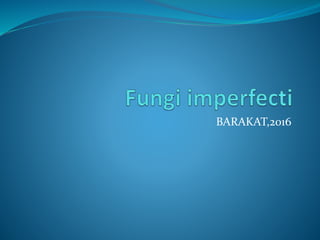
Classification of Fungi Imperfecti and their Orders
- 1. BARAKAT,2016
- 2. Classification of the Fungi imperfecti Following, a classification of the Fungi imperfecti Class Hyphomycetes lacking fruiting bodies Order Moniliales (producing spores on simple conidiophores) Order Stilbellales (producing spores on synnemata) Order Tuberculariales (producing spores in sporodochia) Class Coelomycetes spores produced in fruiting bodies Order Melanconiales (producing spores in acervuli) Order Sphaeropsidales (producing spores in pycnidia) Class Agonomycetes lacking spores Other, according to Dörfelt (1989):[2]
- 3. Form-Classe: Hyphomycetes Form-Ordnung: Agonomycetales Form-Familie: Agonomycetaceae Form-Ordnung: Moniliales Form-Familie: Moniliaceae Form-Familie: Dematiaceae Form-Familie: Stilbellaceae Form-Familie: Tuberculariaceae Form-Classe: Coelomycetes Form-Ordnung: Melanconiales Form-Familie: Melanconiaceae Form-Ordnung: Sphaeropsidales Form-Familie: Sphaeropsidaceae
- 4. Characteristics of "fung" in the broad sense Achlorophyllous: Fungi cannot make their own food like plants. They are heterotrophs and depend upon other organism for their carbon source. Heterotrophs can further be divided into the following categories: Parasites: Organisms that derives their nutrition from the protoplasm of another organism (=host). Saprobes: Organisms that obtains their carbon source (=food) from the by-products of organisms or dead organisms. However, if the opportunity arises, some saprobes may become parasitic. Such organisms are said to be facultative parasites. Symbiosis: In the strict sense, this term refers to the habitual "living together" of different species. As such, there are a number of different categories of relationships that may fit under this term. However, we will define it in its most common usage: "The intimate association of two dissimilar organisms in a mutually beneficial relationship, e.g. lichens and mycorrhizae." This type of symbiosis is specifically referred to as a mutualistic symbiosis.
- 5. 2. Eukaryotic: Fungi have membrane bound organelles, i.e. nucleus, mitochondrion, E.R., etc. Once upon a time filamentous bacteria called Actinomycetes were classified with fungi, but this is no longer the case. 3. The the body or assimilative part of the fungus (=thallus) usually takes the following forms: A. Yeast: Unicellular fungi that reproduce, asexually, by budding or fission (terms to be defined later). B. Mycelium: The collective, filamentous strands that make up the fungal thallus. Strands of mycelium is referred to as hyphae (sing.=hypha). Mycelium may be of two types: i. Septate: Mycelium that is divided into discreet cells by cell walls that are laid down at regular intervals along the length of the mycelium. These cell walls are called septa (sing.= septum). ii. Coenocytic: Mycelium that is not divided up by septa and forms a continuous tubular network. Septa, however, are present occasionally, especially where reproductive structures occur and where the cell wall of the mycelium has been compromised. C. Some species may have thalli that are mycelium and yeast. Such fungi are said to be dimorphic (=two forms).
- 6. Deuteromycotina Ainsworth and Bisby (1971) 3 order:- Blastomycetes Hyphomycetes Coelomycetes
- 7. Bessey (1950) Moniliales Sphaeropsidales Melanconiales
- 9. Kingdom: Protista Division: Myxomycota (Currently classified with protozoans) Flagellated Fungi Division: Hyphochytridiomycota Division: Oomycota The above two divisions have also been placed in a recently erected Kingdom: Stramenopila. This kingdom includes the divisions Phaeophyta and Chrysophyta, which you have already studied in the algae portion of this course
- 11. Kingdom: Myceteae (=Fungi) Division: Chytridiomycota Division: Zygomycota Division: Ascomycota Class: Ascomycetes Order: Saccharomycetales and Schizosaccharomycetales (Yeast) Filamentous Ascomycetes Order: Eurotiales (Fruiting body a cleistothecium) Order: Sordariales and Xylariales (Fruiting body a perithecium) Order: Pezizales (Fruiting body an apothecium) Order: Dothideales (Fruiting body an ascostroma) Division: Basidiomycota
- 15. Class: Basidiomycetes Order: Agaricales (Mushrooms) Order: Lycoperdales, Phallales and Nidulariales (Puffballs) Order: Aphyllophorales (Polypores) Order: Tremellales, Dacrymycetales and Auriculariales (Jelly Fungi) Class: Teliomycetes (Rust) Class: Ustomycetes (Smuts) Division: "Deuteromycota" (Asexual Fungi)
